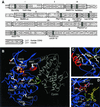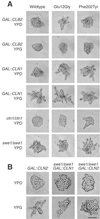Enhanced cell polarity in mutants of the budding yeast cyclin-dependent kinase Cdc28p
- PMID: 11694591
- PMCID: PMC60278
- DOI: 10.1091/mbc.12.11.3589
Enhanced cell polarity in mutants of the budding yeast cyclin-dependent kinase Cdc28p
Abstract
The yeast cyclin-dependent kinase Cdc28p regulates bud morphogenesis and cell cycle progression via the antagonistic activities of Cln and Clb cyclins. Cln G1 cyclins direct polarized growth and bud emergence, whereas Clb G2 cyclins promote isotropic growth of the bud and chromosome segregation. Using colony morphology as a screen to dissect regulation of polarity by Cdc28p, we identified nine point mutations that block the apical-isotropic switch while maintaining other functions. Like a clb2 Delta mutation, each confers tubular bud shape, apically polarized actin distribution, unipolar budding, and delayed anaphase. The mutations are all suppressed by CLB2 overexpression and are synthetically lethal with a CLB2 deletion. However, defects in multiple independent pathways may underlie their common phenotype, because the mutations are scattered throughout the CDC28 sequence, complement each other, and confer diverse biochemical properties. Glu12Gly, a mutation that alters a residue involved in Swe1p inhibition of Cdc28p, was unique in being suppressed by deficiency of SWE1 or CLN1. With wild-type CDC28, filament formation induced by CLN1 overexpression was markedly decreased in a SWE1 deletion. These results suggest that Swe1p, via inhibition of Clb2p/Cdc28p, may mediate much of the effect of Cln1p on filamentous morphogenesis.
Figures






Similar articles
-
Cytoplasmic Clb2 is required for timely inactivation of the mitotic inhibitor Swe1 and normal bud morphogenesis in Saccharomyces cerevisiae.Curr Genet. 2007 Jan;51(1):1-18. doi: 10.1007/s00294-006-0102-1. Epub 2006 Oct 11. Curr Genet. 2007. PMID: 17033818
-
Identification of Clb2 residues required for Swe1 regulation of Clb2-Cdc28 in Saccharomyces cerevisiae.Genetics. 2008 Jun;179(2):863-74. doi: 10.1534/genetics.108.086611. Genetics. 2008. PMID: 18558651 Free PMC article.
-
Regulation of cell cycle progression by Swe1p and Hog1p following hypertonic stress.Mol Biol Cell. 2001 Jan;12(1):53-62. doi: 10.1091/mbc.12.1.53. Mol Biol Cell. 2001. PMID: 11160822 Free PMC article.
-
Eavesdropping on the cytoskeleton: progress and controversy in the yeast morphogenesis checkpoint.Curr Opin Microbiol. 2006 Dec;9(6):540-6. doi: 10.1016/j.mib.2006.10.004. Epub 2006 Oct 19. Curr Opin Microbiol. 2006. PMID: 17055334 Review.
-
The cyclin family of budding yeast: abundant use of a good idea.Trends Genet. 1998 Feb;14(2):66-72. doi: 10.1016/s0168-9525(97)01322-x. Trends Genet. 1998. PMID: 9520600 Review.
Cited by
-
Molecular basis of the functional distinction between Cln1 and Cln2 cyclins.Cell Cycle. 2012 Aug 15;11(16):3117-31. doi: 10.4161/cc.21505. Epub 2012 Aug 14. Cell Cycle. 2012. PMID: 22889732 Free PMC article.
-
Morphogenesis and the cell cycle.Genetics. 2012 Jan;190(1):51-77. doi: 10.1534/genetics.111.128314. Genetics. 2012. PMID: 22219508 Free PMC article. Review.
-
Proteostatic tuning underpins the evolution of novel multicellular traits.Sci Adv. 2024 Mar 8;10(10):eadn2706. doi: 10.1126/sciadv.adn2706. Epub 2024 Mar 8. Sci Adv. 2024. PMID: 38457507 Free PMC article.
-
Mutations in the yeast cyclin-dependent kinase Cdc28 reveal a role in the spindle assembly checkpoint.Mol Genet Genomics. 2003 Aug;269(5):672-84. doi: 10.1007/s00438-003-0870-y. Epub 2003 Jun 24. Mol Genet Genomics. 2003. PMID: 12827501
-
Proteostatic tuning underpins the evolution of novel multicellular traits.bioRxiv [Preprint]. 2024 Jan 22:2023.05.31.543183. doi: 10.1101/2023.05.31.543183. bioRxiv. 2024. Update in: Sci Adv. 2024 Mar 8;10(10):eadn2706. doi: 10.1126/sciadv.adn2706. PMID: 37333256 Free PMC article. Updated. Preprint.
References
-
- Amberg DC, Basart E, Botstein D. Defining protein interactions with yeast actin in vivo. Nat Struct Biol. 1995;2:28–35. - PubMed
-
- Amon A, Irniger S, Nasmyth K. Closing the cell cycle circle in yeast: G2 cyclin proteolysis initiated at mitosis persists until the activation of G1 cyclins in the next cycle. Cell. 1994;77:1037–1050. - PubMed
-
- Brown NR, Noble ME, Endicott JA, Johnson LN. The structural basis for specificity of substrate and recruitment peptides for cyclin-dependent kinases. Nat Cell Biol. 1999;1:438–443. - PubMed
Publication types
MeSH terms
Substances
LinkOut - more resources
Full Text Sources
Molecular Biology Databases

